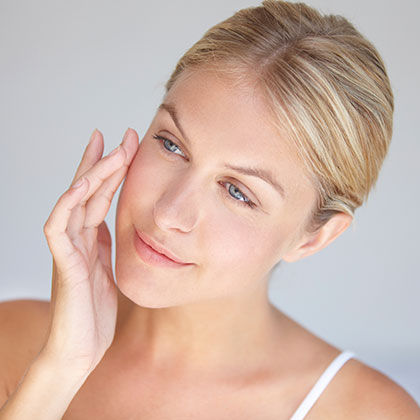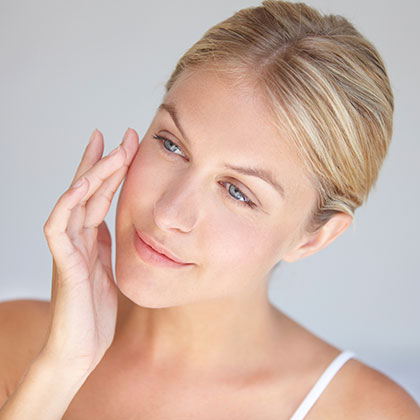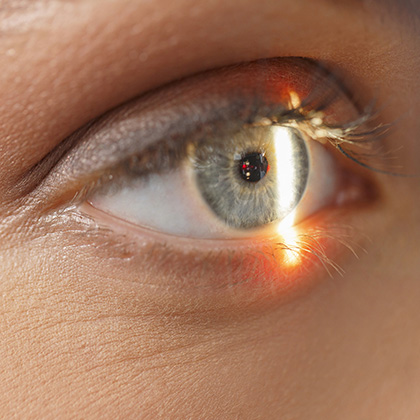Around 23 per cent of the more than two million people in the UK living with sight loss are thought to be affected by a condition that’s the country’s leading cause of visual impairment (i), yet many may not have heard much about it.
Age-related macular degeneration (AMD) is a disease of the macula, a small area in the centre of the retina at back of the eye, through which light passes to the brain. If the macula becomes damaged it can affect your ability to see fine detail properly. Colours also become less vibrant, and if left untreated AMD gradually destroys your sharp, central vision – that is, what you see directly in front of you. This can affect the things you do every day, such as driving and reading.
AMD doesn’t affect your peripheral vision – that is, what you see at the outer edges of your vision – so it doesn’t cause complete blindness. It usually (but not always) affects both eyes, and can progress at a different rate in each eye. Yet despite the fact that it’s the UK’s most common cause of vision impairment, the exact cause of AMD is still unknown.
Are you at risk?
Macular degeneration is thought to affect people over the age of 60 more than other age groups (ii), but it can also happen when you’re younger. Age is the most significant risk factor, but there are other things that may increase your risk too, including the following:
-
Smoking (according to the RNIB, smoking greatly increases your risk of developing AMD (ii))
-
Gender (women are believed to have a greater risk than men)
-
Ethnic background (Caucasians may be more likely to develop AMD than people with darker skin)
-
Genetic susceptibility (you may have a higher risk if you have immediate family members who have AMD – according to Patient, siblings of affected people have a four-times greater chance of developing it (iii))
-
Diet (not eating enough nutrient-rich foods, such as colourful fruit and vegetables, and eating too many foods that are high in fat, cholesterol and high-glycaemic index foods could increase your risk of developing AMD (iii))
-
Researchers believe that drinking just over two units of alcohol every may raise the risk of having early AMD (iv)
-
Sunlight is another possible risk factor, specifically exposure to lots of sunlight during your lifetime (v)
-
Obesity – having a body mass index (BMI) of 30 or higher – is also thought to increase your chances of developing AMD, with experts suggesting a BMI of greater than 30 may increase your risk by about 2.5 times (iii)
What are the signs?
AMD doesn’t cause pain, but there are several general symptoms to look out for, including the following:
-
Blurring in the centre of your vision
-
Distortion of an object's shape, size or colour
-
Straight lines appearing wavy or fuzzy
-
Sensitivity to light
-
Seeing light, shapes and colours that aren't there
Remember, while AMD usually affects both eyes, it can affect just one, so check each eye separately too. Cover each eye in turn and get to know what's normal for each eye individually. To see a simulation of how somebody sees with AMD, watch this YouTube video by the US-based National Eye Institute.
Types of AMD
There are two main types of macular degeneration: wet AMD and dry AMD
Dry AMD
This is the most common and least serious type of the condition, affecting around 90 per cent of cases (vi). It’s what happens when the light-sensitive cells in the macula slowly break down, gradually blurring the central vision in the affected eye.
The most common symptom of dry AMD is slightly blurred vision. For instance, you may have difficulty recognising faces or you may need more light for reading and other tasks. Another common early signs of dry AMD is the presence of small deposits, known as drusen, under the retina. These are most often found in people over the age of 60, and are thought to damage the light cells in the macula.
As dry AMD gets worse, you may see a blurred spot in the centre of your vision, though the loss of vision is gradual and can take a number of years.
Wet AMD
Wet AMD, which is also referred to as neovascular AMD, happens in around one in 10 cases of AMD and six in 10 cases of intermediate or advanced AMD (vi). This happens when abnormal blood vessels behind the retina start to grow under the macula. These new blood vessels cause swelling and bleeding beneath the macula, causing damage to the macular and, eventually, scarring.
Wet AMD can develop very quickly, which means you lose your central vision much faster than with dry AMD. The good news is that there is treatment that can stop the blood vessels from growing and damaging the macula, but it needs to be given quickly.
Does dry AMD progress into wet AMD?
An estimated 10 – 15 per cent of people with dry AMD go on to develop wet AMD (vii). There is, however, no way to tell if or when dry will turn into wet AMD.
Diet and your vision
While experts still don’t know the exact cause of AMD, many believe there are steps you can take to minimise the chances of developing it. One of those steps is to eat a well-balanced diet.
Antioxidants
Certain nutrients are thought to help protect your eyes from sight-impairing diseases such as AMD, including antioxidants that may neutralise harmful substances called free radicals. Among the antioxidants thought to help fight eye damage are lutein and zeaxanthin. Good sources of lutein and zeaxanthin are green vegetables such as kale, broccoli, green beans, peas, sprouts, cabbage, spinach and lettuce, plus fruit including kiwi, papaya and honeydew melons. Other antioxidants thought to benefit eye health include lycopene (tomatoes), astaxanthin (marine algae), beta carotene (carrots, pumpkin, papaya), anthocyanidins (blackcurrants, bilberries), vitamin E (sunflower seeds, nuts, wheat germ oil) and vitamin C (red peppers, strawberries, spring greens).
Minerals
It’s also thought that certain minerals could help maintain good eye health, including zinc and selenium. Eat more seafood, nuts, Quorn, wheat germ and seeds to boost your intake of zinc; and Brazil nuts, tinned tuna, sardines, egg yolks and sunflower seeds for more selenium.
Oily Fish
According to a review of studies on fish consumption and the risk of AMD published in the journal Nutrients, there is evidence that eating fish such as salmon, pilchards, sardines, herring and trout may also help protect your eyes against AMD (viii).
Saturated Fats
Cutting down on the amount of saturated fat in your diet – that is, fats mostly found in animal products such as beef, lamb, pork, lard, butter, cream and cheese – may also help to reduce your risk of AMD. Check the nutrition labels on processed foods and baked goods too, as these can often be high in saturated fats.
5 ways to protect your eyes
Wear sunglasses
Wearing sunglasses may help protect against AMD because the UVA and UVB rays in sunlight can harm your macula. Make sure your sunglasses have the correct level of protection – choose a pair that carries the CE mark or British Standard BS EN ISO 12312-1:2013.
Have regular check-ups
Having an eye test once every two years – or as often as your optician recommends – is important because it can help spot the very early signs of AMD. Even if you can see perfectly well, there may be early damage happening that could be picked up by an eye test. Getting treatment as early as possible is crucial, since it can make the treatment more effective and prevent any damage from getting worse. Currently, a two-yearly eye test is recommended for most people. However, if you are aged 40 or older and in an at-risk group for an eye condition (if you have a family history of eye conditions, for instance) you may need an eye test more often than every two years.
Give up smoking
Smokers are more likely to lose their sight than non-smokers, with smoking linked to an increased risk for AMD (according to the RNIB, there is evidence that smokers are four times more likely to develop it than people who have never smoked (ix)). That’s because the chemicals in tobacco damage the blood vessels in the macula. And the more you smoke – and the longer you smoke – the higher your risk. The good news is giving up smoking reduces your risk over time, and 20 years after you quit your risk of developing AMD should be the same as that of a non-smoker (ix).
Watch your weight
Obesity increases your risk of eye health problems, including AMD. If your body mass index (BMI) is 30 or more, consider healthy ways of losing weight and maintaining a BMI of between 18.5 and 24.9, which is considered the healthy range. Remember that as well as trying to eat fewer calories than your body needs, you should also be aiming to be more physically active (150 minutes of moderate-intensity activity a week is recommended).
Know your family history
AMD can run in families, so if yours has a history of an eye condition it's even more important to have your eyes checked regularly and protect yourself by putting other lifestyle measures into place.
Supplementary Benefits for Eyes
Currently there is no treatment for dry AMD, but treatments that stop the growth of new blood vessels – such as injections of anti-vascular endothelial growth factor medicines – may help in the case of wet AMD if they’re given quickly enough.
However, one of the ways to protect against the development of AMD may include taking certain natural supplements designed to improve eye health:
Lutein and Zeaxanthin
These belong to a group of natural antioxidant plant pigments called carotenoids that are found in high concentrations in the macular as well as in the surrounding tissue of the retina. Some studies show that lutein and zeaxanthin may be promising in terms of preventing AMD (x), and that they may work by colouring the macula and thereby protecting it against the sun’s rays.
Astaxanthin
Like lutein and zeaxanthin, astaxanthin is a carotenoid. Indeed it’s a particularly powerful antioxidant (xi), with some researchers believing it may help prevent AMD and other retinal disorders associated with oxidative stress (xii). An Italian study has also found people with existing AMD may experience improvements in their vision – notably clarity and contrast sensitivity – if they take a supplement containing astaxanthin along with zeaxanthin and lutein for two years (xiii).
Astaxanthin is derived from a freshwater microalgae called Haematococcus pluvialis, and is the red pigment in the algae that gives fish and shellfish like salmon and lobster their distinctive red/pink colour.
You can get astaxanthin in your diet by eating foods such as salmon, lobster, shrimp, crawfish and crab. However it’s unlikely that you’d be able to eat enough to get the amount of astaxanthin needed to see any vision benefits. Taking a high-quality supplement, however, would provide a more beneficial dose of astaxanthin – plus it’s the perfect option for anyone who’s not keen on fish or seafood.
Read more about astaxanthin and its benefits for eye health here
Plant Flavonoids
Other plant compounds known as flavonoids are known to support blood vessel health, including the blood vessels in the eyes. Flavonoids thought to boost eye health include anthocyanidins, which are found in dark-coloured fruits such as blueberry and bilberry, and oligomeric proanthycyanidins, which are found in grape seeds. Studies suggest these substances may help prevent or treat AMD (xiv).
Ginkgo Biloba
This herb also contains flavonoids and is widely used to increase circulation, including blood flow to the eyes (and in particular the optic nerve). In one study, volunteers with macular degeneration took either 60mg of ginkgo biloba a day or a higher 240mg daily dose. Both groups found their vision had improved, with those taking the higher dose reporting more significant improvements (xv). A Spanish study also concludes that ginkgo biloba extracts may help improve neurodegenerative retinal diseases such as AMD, but more research is needed to determine the herb’s safety and efficacy in the disease processes (xvi).
High-Strength Multivitamin and Mineral
Taking a good-quality multivitamin and mineral supplement that contains antioxidant vitamins A, C and E and the mineral zinc may help protect against AMD. One study, which included 3,640 individuals in the early stage of AMD, suggests antioxidants combined with zinc may even slow the progression of the condition (xvii). Zinc also has official backing from the EU via the European Food Safety Authority’s (EFSA’s) confirmation of a relationship between zinc and maintenance of normal vision.
Fish Oils
One of the omega-3 fatty acids found in fish oil – namely docosahexaenoic acid (DHA) – has also been approved by the EFSA as contributing to the maintenance of normal vision (xviii). It’s also thought that people who eat a diet rich in omega-3 fatty acids may have a lower risk of developing AMD, and that fish oil may support eye health in general (xix).
If you are a vegetarian or vegan, you can still benefit from the omega-3 oils found in fish by taking an omega-3 supplement that contains the natural triglyceride (TG) form of omega-3, which is sourced from plant organisms called microalgae.
Living with AMD can be a challenge, but this guide shows there is lots you can do to protect your vision against any further deterioration – or even to help prevent the disease in the first place if your eyes are healthy. For more information on healthy vision, take a look around our eye health hub articles.
References:
-
RNIB Eye health and sight loss stats and facts, April 2018. Available online: https://www.bssa.uk.net/pdfs/information-sheet.pdf
-
Available online: https://www.rnib.org.uk/sites/default/files/Understanding_AMD_2019.pdf
-
Available online: https://patient.info/doctor/age-related-macular-degeneration-pro
-
Adams. MK et al. 20/20 , Alcohol and Age-related Macular Degeneration: The Melbourne Collaborative Cohort Study. Am J Epidemiol. 2012 Aug 15;176(4):289-98.Available online: https://academic.oup.com/aje/article/176/4/289/120828
-
Hirakawa. M et al, Age-related maculopathy and sunlight exposure evaluated by objective measurement. Br J Ophthalmol. 2008 May;92(5):630-4.Available online: https://www.ncbi.nlm.nih.gov/pubmed/18441173
-
Available online: https://patient.info/eye-care/visual-problems/age-related-macular-degeneration
-
Available online: https://www.macularsociety.org/dry-amd
-
Wei Zhu. et al, Fish Consumption and Age-related Macular Degeneration Incidence: A Meta-Analysis and Systematic Review of Prospective Cohort Studies.. Nutrients. 2016 Nov;8 (11):743.Available online: https://www.ncbi.nlm.nih.gov/pmc/articles/PMC5133126/
-
Available online: https://www.rnib.org.uk/nb-online/no-smoking-day-2017
-
Landrum. JT, Bone. RA, Kilburn. MD. The macular pigment: a possible role in protection from age-related macular degeneration. Adv Pharmacol. 1997;38:537-556.
Hammond Jr. BR , Wooten. BR, Snodderly. DM. Density of the human crystalline lens is related to the macular pigment carotenoids, lutein and zeaxanthin. Optom Vis Sci. 1997;74:499-504.
Ma L et al., Lutein, Zeaxanthin and Meso-zeaxanthin Supplementation Associated with Macular Pigment Optical Density. Nutrients. 2016 Jul 12;8(7). Pij: E426.Available online: https://www.ncbi.nlm.nih.gov/pubmed/27420092 -
Miki W. et al., Biological functions and activities of animal carotenoids. Pure Appl. Chem. 1991;63:141-6. Available online: https://www.researchgate.net/publication/244741723_Biological_Functions_and_Activities_of_Animal_Carotenoids
-
Li Z. et al., Astaxanthin protects ARPE-19 cells from oxidative stress via upregulation of Nrf2-regulated phase II enzymes through activation of PI3K/Akt. Mol Vis. 2013;19:1656-1666. Available online: https://www.ncbi.nlm.nih.gov/pmc/articles/PMC3725964
-
xiii. Piermarocchi S. et al., Carotenoids in Age-Related Maculopathy Italian Study (CARMIS): two-year results of a randomised study. Eur J Ophthalmol. 2012;22(2):216-225. Available online: https://journals.sagepub.com/doi/10.5301/ejo.5000069
-
Scharrer. A, Ober. M. Anthocyanosides in the treatment of retinopathies. Klin Monatsbl Augenheilkd. 1981;178:386-389. Caselli. L. Clinical and electroretinographic study on activity of anthocyanosides. Arch Med Intern (Parma). 1985;37:29-35.
-
Fies. P, Dienel. A. Ginkgo extract in impaired vision—treatment with special extract EGb 761 of impaired vision due to dry senile macular degeneration. Wien Med Wochenschr. 2002;152:423-426.
-
Martinez-Solic. I et al., Neuroprotective Potential of Ginkgo biloba in Retinal Diseases. Planta Med. 2019 Nov;85(17):1292-1303.Available online: https://www.ncbi.nlm.nih.gov/pubmed/31266069
-
Age-Related Eye Disease Study Research Group. A randomized, placebo-controlled, clinical trial of high-dose supplementation with vitamins C and E, beta carotene, and zinc for age-related macular degeneration and vision loss: AREDS report no. 8. Arch Ophthalmol. 2001 Oct;119(10):1417-36. Available online: https://www.ncbi.nlm.nih.gov/pubmed/11594942
-
Available online: https://efsa.onlinelibrary.wiley.com/doi/epdf/10.2903/j.efsa.2010.1734
-
Available online: https://efsa.onlinelibrary.wiley.com/doi/epdf/10.2903/j.efsa.2010.1734
-
Available online: https://www.allaboutvision.com/nutrition/fatty_acid_1.htm
Related Posts
Disclaimer: The information presented by Nature's Best is for informational purposes only. It is based on scientific studies (human, animal, or in vitro), clinical experience, or traditional usage as cited in each article. The results reported may not necessarily occur in all individuals. Self-treatment is not recommended for life-threatening conditions that require medical treatment under a doctor's care. For many of the conditions discussed, treatment with prescription or over the counter medication is also available. Consult your doctor, practitioner, and/or pharmacist for any health problem and before using any supplements or before making any changes in prescribed medications.
Related Posts

Christine
Christine Morgan has been a freelance health and wellbeing journalist for almost 20 years, having written for numerous publications including the Daily Mirror, S Magazine, Top Sante, Healthy, Woman & Home, Zest, Allergy, Healthy Times and Pregnancy & Birth; she has also edited several titles such as Women’ Health, Shine’s Real Health & Beauty and All About Health.
View More






